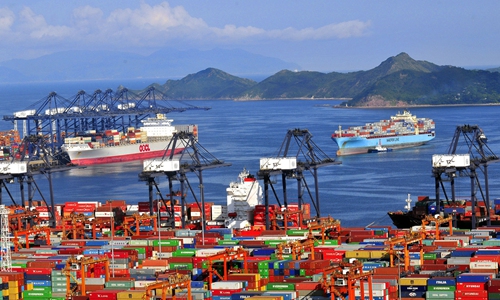US’ trade deficit is widening to 14-year high despite Trump’s big talk
By GT staff reporters Source: Global Times Published: 2020/10/8 22:27:06

China-US trade
The US' trade deficit in August rose to a 14-year high despite waging a tariff war with major trade partners, breaking US President Donald Trump's vow to significantly narrow the trade gap.
Trump's failed attempt to reduce the country' trade deficit, even as it imposes taxes on products from its major trade partners, including China, has seen him "shoot himself in the foot" right before the upcoming US presidential election, experts say.
In August, the US' trade deficit rose 5.9 percent to $67.1 billion, marking the highest deficit since 2006. Although exports were up 2.2 percent, they were overshadowed by imports, jumping 3.2 percent, to $239 billion.
From January to August this year, the US' overall trade deficits rose 5.7 percent year-on-year to $421.8 billion, according to the latest data from the US Census Bureau. Its gap with China dropped by 6.7 percent, but remained at $26.4 billion. Meanwhile, throughout this year, China's exports to the US rose by 20 percent, compared to the 1.8 percent increase in US exports to China.
The imported items with the largest increases included crude oil, cars and vehicle parts. According to the US Census Bureau, China's vehicle part exports more than doubled in August compared to July, to over $1.2 billion.
China's increase in exports is mainly due to the country's successful control of the coronavirus and the country's mature supply chain, which is the first in the world to fully recover, ready to produce and cater to the global market, where production has been on hold, Bai Ming, deputy director of the Ministry of Commerce's International Market Research Institute.
"The demand for consumer products, which constitutes a large part of China's exports to the US, is inelastic," Bai said. "Although business activities in the US — as well as the rest of world — are still depressed, demand is being driven up by importers as the holiday period approaches."
"However, despite the trade wars the US has waged on its trade partners, its rising deficit is not going to look good on Trump," Bai added. "It means he has most likely shot himself in the foot."
According to statistics from the US Census Bureau, the 2.2 percent increase in exports was driven by a surge of shipments of soybeans, which is largely attributable to China's rising purchases, Tian Yun, vice director of the Beijing Economic Operation Association, told the Global Times.
Soybeans are an important export product from the US, especially under the phase one trade deal, in which China pledged to purchase $200 billion of US goods and services. From 2020 to 2021, China's orders for US soybeans amounted to almost 18 million tons, with a total value of $6.5 billion. China also ordered 10 million tons of corn from the US, double the amount from 2011 to 2012.
However, despite China's commitment to the phase one trade deal, the COVID-19 outbreak upended supply and demand. As of August, only around 33 percent of purchases in the phase one deal were fulfilled, according to media reports.
"Due to COVID-19, many US producers have been unable to supply to China even though there is ample demand," Tian said.
Posted in: ECONOMY,BIZ FOCUS